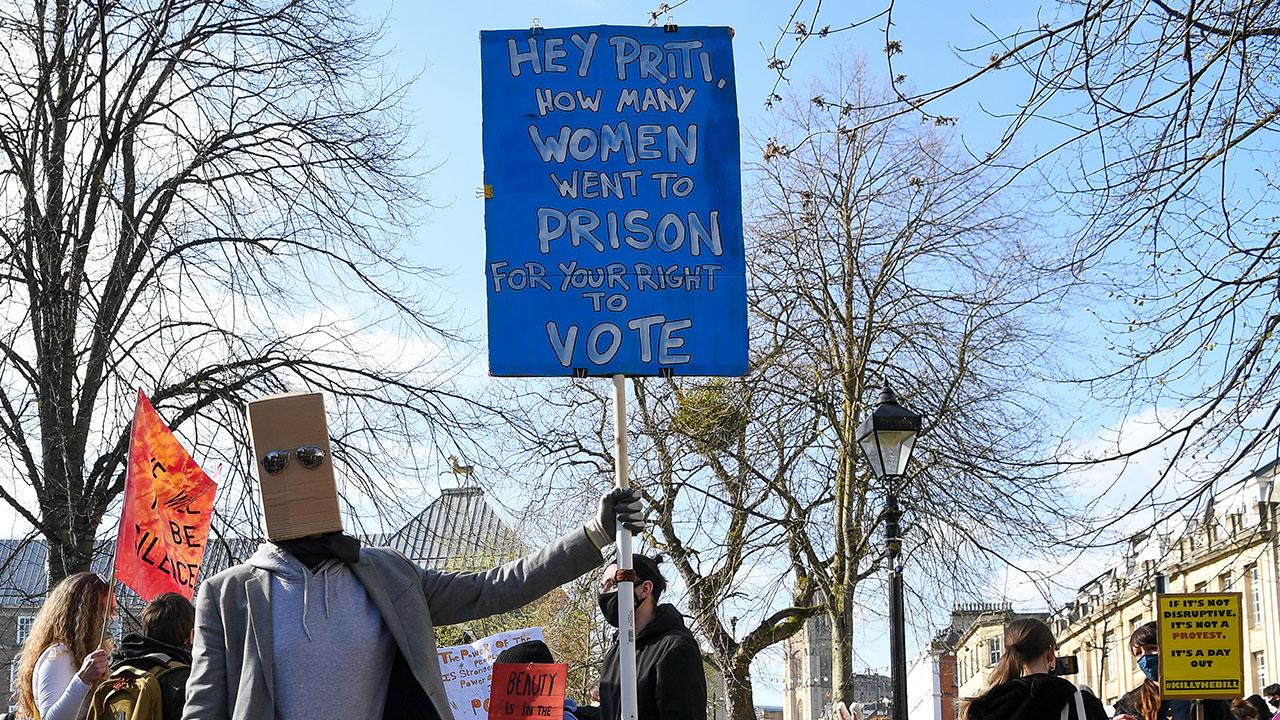One Man Protest
Solidarity isn't for everyone
Solidarity isn't for everyone
On 20 January this year, protestors opposing the UK Prime Minister’s tough stance on immigration briefly occupied Vauxhall Bridge in London, close to the Houses of Parliament, and unfurled a banner reading ‘Queer Solidarity Smashes Borders’. It’s a slogan that could swing both ways, as it were. One reading suggests that a defined group – queers – expresses unity with migrants and opposition to border control; another interpretation would be that it calls for a queer kind of solidarity, a redefined or dissident form of collective politics, which would undo national boundaries. Initially reading it the first way, my reaction was to roll my eyes: ‘Solidarity? Seriously?’
Now, you’re probably asking yourself: ‘Who on earth could object to solidarity? Surely, at least for this protest-themed issue of frieze, you could link arms with your colleagues and join in?’ I’ll admit, I’m a misanthrope – have you seen the state of the world? – but I’m especially grouchy when it comes to expressions of solidarity. These declarations appear to be newly ubiquitous on my Facebook feed, and not just in relation to politics: even posts about everyday frustrations – losing your keys, getting dumped, missing out on a party – are met with ‘been there too, solidarity’ or the even more archaic, ‘solidarity, comrade’. It’s terminology more reminiscent of fiery students’ union debates in the 1970s than the chatter of social media today and I frequently have to check friends’ profile pictures to make sure they’re not sporting shaggy hair and brown flares. However, as the protest banner or phrases such as ‘I’m with her’ and ‘We are the 99 percent’ attest, expressions of belonging are central to popular protest today.
Perhaps the revival of the anachronistic language of solidarity should be no surprise: in many countries, left- and right-wing politics are as polarized today as they were in the mid-20th century, when ‘solidarity, comrade’ was last shouted from the picket line. But the notion of collective identity has long been a problem for those engaged in queer and gender politics, and is likely to be so again given that it’s back in vogue, particularly in the art world.
At a recent seminar on art and feminism, I raised the idea of ‘the sisterhood’, the term used in the 1960s to describe women’s unity in the fight against patriarchy. To this savvy, post-identity politics crowd, the term seemed laughable: ‘I don’t think anyone would try to revive it now,’ shot back one experienced curator. As much as it galvanized the women’s movement, ‘sisterhood’ has come to function as a shorthand for the white, middle-class and heterosexist assumptions of much second-wave feminism: ‘Who are you calling sister?’ protested black, working-class, developing-world and lesbian feminists. Having at least one common enemy doesn’t necessarily mean all women are oppressed in the same ways, identify with the same representations or share the same aims. Implicit in the idea of sisterhood was a flattening-out of differences of class, race or sexuality, as if being a woman were a universal and essential state, binding feminists together as a family. The idea that feminism might be dysfunctional in the way families often are, or full of contradictions and internal hierarchies, isn’t accounted for by this model of solidarity.
It’s a problem that resurfaced recently with the Women’s March on Washington. Initially called the Million Women March, both these names, critics pointed out, came from African-American feminist protests, while the organizers of the anti-Trump marches were all white: so, who gets to represent ‘all women’ here? Solidarity, when it shifts from shared ideals into the assumption of shared identity, becomes ironically exclusive in its demand for cohesion.
Much of the art world’s renewed interest in queer politics would appear to further entrench, rather than challenge, these problems. I’ve noticed a tendency for artists and exhibitions to issue press releases denouncing ‘cis white men’ or make work critiquing ‘straight cis gender people’, as if anyone who identifies as such will inevitably be an enforcer of heteronormativity. Oppositional politics are often shaped by the very thing they oppose. Accusations flung at ‘cis white men’ reinforce the kinds of essentialism that those who believe in gender fluidity would seek to escape. I’m put in mind of the self-defeating gestures of those who object to Donald Trump’s misogyny while also seeking to shame Melania Trump for her nude modelling. Don’t get personal, get structural; rather than mobilizing one identity or person against another, question the very logic of identification or of political community. An us vs. them approach also risks defining who is and isn’t queer, producing the kind of exclusive, queerer-than-thou grouping that I feared on seeing that protest banner on Vauxhall Bridge.
Of course, if queer solidarity means reimagining solidarity in ways that are more open, less defining, then I’m all for it. Maybe it’s time to revisit a set of ideas, once fashionable and now seldom mentioned, that try to imagine forms of collective action based on association rather than cohesion. These range from Giorgio Agamben’s notion of a community without essence or Jean-Luc Nancy’s idea of community without unity to Chantal Mouffe and Ernesto Laclau’s emphasis on democracy as antagonism not consensus, or the network of affiliations that is Michael Hardt and Antonio Negri’s concept of the multitude. Perhaps it’s possible to imagine a version of solidarity which, as queer theorist Sara Ahmed suggested in The Cultural Politics of Emotion (2004), recognizes that while ‘we do not have the same feelings, or the same lives, or the same bodies, we do live on common ground’. That’s the kind of capacious, queer solidarity I can support. As abstract, contradictory and potentially unrealizable as those ideas might be, surely they’re worth hanging on to as we march together.























